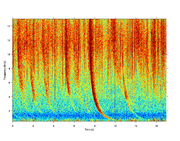
Radio atmospheric
Encyclopedia

Broadband
The term broadband refers to a telecommunications signal or device of greater bandwidth, in some sense, than another standard or usual signal or device . Different criteria for "broad" have been applied in different contexts and at different times...
electromagnetic
Electromagnetic radiation
Electromagnetic radiation is a form of energy that exhibits wave-like behavior as it travels through space...
impulse that occurs as a result of natural atmospheric lightning
Lightning
Lightning is an atmospheric electrostatic discharge accompanied by thunder, which typically occurs during thunderstorms, and sometimes during volcanic eruptions or dust storms...
discharges. Sferics may propagate from their lightning source without major attenuation
Attenuation
In physics, attenuation is the gradual loss in intensity of any kind of flux through a medium. For instance, sunlight is attenuated by dark glasses, X-rays are attenuated by lead, and light and sound are attenuated by water.In electrical engineering and telecommunications, attenuation affects the...
in the Earth-Ionosphere waveguide
Earth-Ionosphere waveguide
The Earth–ionosphere waveguide refers to the phenomenon in which certain radio waves can propagate in the space between the ground and the boundary of the ionosphere.Because the ionosphere contains charged particles, it can behave as a conductor...
, and can be received thousands of kilometers from their source. On a time-domain plot, a sferic may appear as a single high-amplitude spike in the time-domain data. On a spectrogram
Spectrogram
A spectrogram is a time-varying spectral representation that shows how the spectral density of a signal varies with time. Also known as spectral waterfalls, sonograms, voiceprints, or voicegrams, spectrograms are used to identify phonetic sounds, to analyse the cries of animals; they were also...
, a sferic appears as a vertical stripe (reflecting its broadband and impulsive nature) that may extend from a few kHz to several tens of kHz, depending on atmospheric conditions.
Sferics received from about distance or greater have their frequencies slightly offset in time, producing tweeks.
When the electromagnetic energy from a sferic escapes the Earth-Ionosphere waveguide
Waveguide
A waveguide is a structure which guides waves, such as electromagnetic waves or sound waves. There are different types of waveguides for each type of wave...
and enters the magnetosphere
Magnetosphere
A magnetosphere is formed when a stream of charged particles, such as the solar wind, interacts with and is deflected by the intrinsic magnetic field of a planet or similar body. Earth is surrounded by a magnetosphere, as are the other planets with intrinsic magnetic fields: Mercury, Jupiter,...
, it becomes dispersed
Dispersion (optics)
In optics, dispersion is the phenomenon in which the phase velocity of a wave depends on its frequency, or alternatively when the group velocity depends on the frequency.Media having such a property are termed dispersive media...
by the near-earth plasma
Plasma (physics)
In physics and chemistry, plasma is a state of matter similar to gas in which a certain portion of the particles are ionized. Heating a gas may ionize its molecules or atoms , thus turning it into a plasma, which contains charged particles: positive ions and negative electrons or ions...
, forming a whistler
Whistler (radio)
A whistler is a very low frequency electromagnetic wave which can be generated, for example, by lightning. Frequencies of terrestrial whistlers are 1 to 30 kHz, with maximum usually at 3 to 5 kHz. Although they are electromagnetic waves, they occur at audio frequencies, and can be...
signal. Because the source of the whistler is an impulse (i.e., the sferic), a whistler may be interpreted as the impulse response
Impulse response
In signal processing, the impulse response, or impulse response function , of a dynamic system is its output when presented with a brief input signal, called an impulse. More generally, an impulse response refers to the reaction of any dynamic system in response to some external change...
of the magnetosphere (for the conditions at that particular instant).
See also
- LightningLightningLightning is an atmospheric electrostatic discharge accompanied by thunder, which typically occurs during thunderstorms, and sometimes during volcanic eruptions or dust storms...
- 1955 Great Plains tornado outbreak1955 Great Plains tornado outbreakThe 1955 Great Plains tornado outbreak was a deadly tornado outbreak that struck the southern and central U.S Plain States on May 25–26, 1955. It produced at least 46 tornadoes across 7 states including 2 F5 tornadoes in Blackwell, Oklahoma and Udall, Kansas. The outbreak killed 102 from 3...
http://www.srh.noaa.gov/oun/wxevents/19550525/stormelectricity.php - Whistler (radio)Whistler (radio)A whistler is a very low frequency electromagnetic wave which can be generated, for example, by lightning. Frequencies of terrestrial whistlers are 1 to 30 kHz, with maximum usually at 3 to 5 kHz. Although they are electromagnetic waves, they occur at audio frequencies, and can be...

